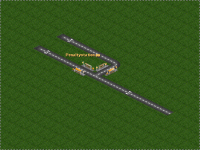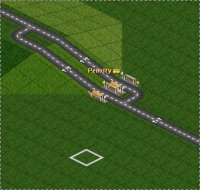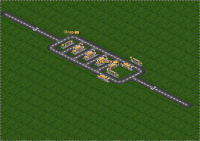Road Vehicle Networking
From #openttdcoop wiki
Contents
Basics
Balacing
A major problem of all networks in Ottdcoop is balancing. A new line is only good if it gets traffic from the other lines so that the overall traffic is less dense. For roads have no signals the possibilities of road vehicle networks are very limited. The only way to split traffic is by using the pathfinders penalties. Buses don't make any penalty on buses behind them, that's why a bus never leave his road unless we force him to. The only way to penalty them is by dummy stations. One stations is a minor penalty, a station with a bus inside is a huge penalty. So it's possible to split traffic: one bus drives through one of the stations and is causing a penalty to those buses behind which choose another path and so on.
One problem of this technique is, that it's only possible to split lines with a constant stream of road vehicles. Sideline balancing has the problem that it's not possible to build any prios, so it's needed to balance sidelines by conneting them only to some of the mainlinelines.
Speed
All of the following thought are about the realistic acceleration model. The original tends to much slower buses wich is much more trouble. Might be fun might be not.
First of all curves slow down buses to around 75 percent of their maxspeed. As it's unusual to double curves the only way to avoid this problem is to avoid curves on mainlines as much as possible. The second thing is about slopes. Slowdown at slopes is related to the slopeness setting and the power of the buses so slopes might be no problem at all, if they become a problem you may double them.
Stations
One good thing about Roadvehicleplatforms is that they can be used from both sides and roro by default. Don't use the terminus stations at all for they are shit. To keep the platform count low we should build a station design were roadvehicle can enter from both sides. Another good thing is that when one side only heads right in curves and the other side the opposite way they don't interfer each other as shown in the FPP Drop Example of PSG 226.


